Remote Sensing Monitoring of Durum Wheat under No Tillage Practices by Means of Spectral Indices Interpretation: A Preliminary Study
Abstract
1. Introduction
2. Materials and Methods
2.1. Field Test Description
2.2. Machines and Practices for DW Cultivation
2.3. The Experimental Design
2.4. The Image Analysis Methodology
3. Results and Discussion
3.1. Vegetation Index NDVI and Grain Yield
3.2. NMDI and NDWI Water Content Indexes
3.3. Statistical Analysis
4. Conclusions
Author Contributions
Funding
Institutional Review Board Statement
Informed Consent Statement
Acknowledgments
Conflicts of Interest
References
- International Grains Council (IGC). Available online: https://www.igc.int/en/subscriptions/subscription.aspx (accessed on 17 July 2022).
- Istituto di Servizi per il Mercato Agricolo Alimentare (ISMEA). Available online: https://www.ismeamercati.it/seminativi/cereali (accessed on 17 July 2022).
- Colecchia, S.A.; Basso, B.; Cammarano, D.; Gallo, A.; Mastrangelo, A.M.; Pontieri, P.; Del Giudice, L.; Pignone, D.; De Vita, P. On the relationship between N management and grain protein content in six durum wheat cultivars in Mediterranean environment. J. Plant Interact. 2012, 8, 271–279. [Google Scholar] [CrossRef]
- Di Fonzo, N.; De Vita, P.; Gallo, A.; Fares, C.; Padalino, O.; Troccoli, A. Durum Wheat, Semolina and Pasta Quality. Crop Management Efficiency as a Tool to Improve Durum Wheat Quality in Mediterranean Areas; INRA, Ed.; Montpellier: Paris, France, 2001; pp. 67–82. [Google Scholar]
- Randall, P.J.; Moss, H.J. Some effects of temperature regime during grain filling on wheat quality. Aust. J. Agric. Res. 1990, 41, 603–617. [Google Scholar] [CrossRef]
- Flagella, Z. Nutritional and technological quality of the durum wheat. Ital. J. Agron. 2006, 1, 203–239. [Google Scholar] [CrossRef]
- Yang, H.; Reichert, P.; Abbaspour, K.C.; Zehnder, A.J.B.A. Water Resources Threshold and its Implications for Food Security. Environ. Sci. Technol. 2003, 37, 3048–3054. [Google Scholar] [CrossRef] [PubMed]
- Niles, M.T.; Lubell, M.; Brown, M. How limiting factors drive agricultural adaptation to climate change. Agric. Ecosyst. Environ. 2015, 200, 178–185. [Google Scholar] [CrossRef]
- Liliane, T.N.; Charles, M.S. Factors Affecting Yield of Crops. In Agronomy—Climate Change & Food Security; IntechOpen: London, UK, 2020. [Google Scholar]
- Royo, C.; Nazco, R.; Villegas, D. The Climate of the Zone of Origin of Mediterranean Durum Wheat (Triticum durum Desf.) Landraces Affects Their Agronomic Performance. Genet. Resour. Crop Evol. 2014, 61, 1345–1358. [Google Scholar] [CrossRef]
- Food and Agriculture Organization of the United Nations (FAO). The State of the World’s Land and Water Resources for Food and Agriculture; Food and Agriculture Organization of the United Nations (FAO): Rome, Italy, 2021; Available online: https://www.fao.org/3/cb7654en/cb7654en.pdf (accessed on 19 July 2022).
- Kassam, A.; Friedrich, T.; Derpsch, R. Global Spread of Conservation Agriculture. Int. J. Environ. Stud. 2018, 76, 1–23. [Google Scholar] [CrossRef]
- Failla, S.; Pirchio, M.; Sportelli, M.; Frasconi, C.; Fontanelli, M.; Raffaelli, M.; Peruzzi, A. Evolution of smart strategies and machines used for conservative management of herbaceous and horticultural crops in the mediterranean basin: A Review. Agronomy 2021, 11, 106. [Google Scholar] [CrossRef]
- Cantero-MartÍnez, C.; Angás, P.; Lampurlanés, J. Long-term yield and water use efficiency under various tillage systems in Mediterranean rainfed conditions. Ann. Appl. Biol. 2007, 150, 293–305. [Google Scholar] [CrossRef]
- Lal, R. A System Approach to Conservation Agriculture. J. Soil Water Conserv. 2015, 70, 82A–88A. [Google Scholar] [CrossRef]
- Cheikh M’hamed, H.; Bahri, H.; Annabi, M. Conservation Agriculture in Tunisia: Historical, Current Status and Future Perspectives for Rapid Adoption by Smallholder Farmers. In Proceedings of the Second Africa Congress on Conservation Agriculture (2ACCA), Johannesburg, South Africa, 9–12 October 2018; pp. 57–60. [Google Scholar]
- Farooq, M.; Siddique, K. Conservation Agriculture: Concepts, Brief History, and Impacts on Agricultural Systems. In Conservation Agriculture; Springer: Cham, Switzerland, 2015. [Google Scholar]
- Pezzuolo, A.; Dumont, B.; Sartori, L.; Marinello, F.; De Antoni Migliorati, M.; Basso, B. Evaluating the impact of soil conservation measures on soil organic carbon at the farm scale. Comput. Electron. Agric. 2017, 135, 175–182. [Google Scholar] [CrossRef]
- Zheng, C.-Y.; Yu, Z.-W.; Shi, Y.; Cui, S.-M.; Dong, W.; Zhang, Y.-L.; Zhao, J.-Y. Effects of tillage practices on water consumption, water use efficiency and grain yield in wheat field. J. Integr. Agric. 2014, 13, 2378–2388. [Google Scholar] [CrossRef]
- Pittelkow, C.M.; Liang, X.; Linquist, B.A.; van Groenigen, K.J.; Lee, J.; Lundy, M.E.; van Gestel, N.; Six, J.; Venterea, R.T.; van Kessel, C. Productivity limits and potentials of the principles of conservation agriculture. Nature 2015, 514, 365–368. [Google Scholar] [CrossRef]
- Jakab, G.; Madarász, B.; Szabó, J.A.; Tóth, A.; Zacháry, D.; Szalai, Z.; Kertész, Á.; Dyson, J. Infiltration and Soil Loss Changes during the Growing Season under Ploughing and Conservation Tillage. Sustainability 2017, 9, 1726. [Google Scholar] [CrossRef]
- Peng, Z.; Wang, L.; Xie, J.; Li, L.; Coulter, J.A.; Zhang, R.; Luo, Z.; Kholova, J.; Choudhary, S. Conservation Tillage Increases Water Use Efficiency of Spring Wheat by Optimizing Water Transfer in a Semi-Arid Environment. Agronomy 2019, 9, 583. [Google Scholar] [CrossRef]
- Gonzalez-Sanchez, E.J.; Veroz-Gonzalez, O.; Blanco-Roldan, G.L.; Marquez-Garcia, F.; Carbonell-Bojollo, R. A renewed view of conservation agriculture and its evolution over the last decade in Spain. Soil Tillage Res. 2019, 146, 204–212. [Google Scholar] [CrossRef]
- Failla, S.; Ingrao, C.; Arcidiacono, C. Energy consumption of rainfed durum wheat cultivation in a Mediterranean area using three different soil management. Energy 2020, 195, 116960. [Google Scholar] [CrossRef]
- Marszalek, M.; Körner, M.; Schmidhalter, U. Prediction of multi-year winter wheat yields at the field level with satellite and climatological data. Comput. Electron. Agric. 2022, 194, 106777. [Google Scholar] [CrossRef]
- Shafi, U.; Mumtaz, R.; García-Nieto, J.; Hassan, S.A.; Zaidi, S.A.R.; Iqbal, N. Precision Agriculture Techniques and Practices: From Considerations to Applications. Sensors 2019, 19, 3796. [Google Scholar] [CrossRef]
- Sishodia, R.P.; Ray, R.L.; Singh, S.K. Applications of Remote Sensing in Precision Agriculture: A Review. Remote Sens. 2020, 12, 3136. [Google Scholar] [CrossRef]
- Calera, A.; Campos, I.; Osann, A.; D’Urso, G.; Menenti, M. Remote sensing for crop water management: From ET modelling to services for the end users. Sensors 2017, 17, 1104. [Google Scholar] [CrossRef] [PubMed]
- Rud, R.; Cohen, Y.; Alchanatis, V.; Levi, A.; Brikman, R.; Shenderey, C.; Heuer, B.; Markovitch, T.; Dar, Z.; Rosen, C.; et al. Crop water stress index derived from multi-year ground and aerial thermal images as an indicator of potato water status. Precis. Agric. 2014, 15, 273–289. [Google Scholar] [CrossRef]
- Rojas, O.; Vrieling, A.; Rembold, F. Assessing drought probability for agricultural areas in Africa with coarse resolution remote sensing imagery. Remote Sens. Environ. 2011, 115, 343–352. [Google Scholar] [CrossRef]
- Agrawal, S.; Chakraborty, A. Evaluation of ESACCI satellite soil moisture product using in-situ CTCZ observations over India. J. Earth Syst. Sci. 2020, 129, 129. [Google Scholar] [CrossRef]
- Spennemann, P.C.; Fernández-Long, M.E.; Gattinoni, N.N.; Cammalleri, C.; Naumann, G. Soil moisture evaluation over the Argentine Pampas using models, satellite estimations and in-situ measurements. J. Hydrol. 2020, 31, 100723. [Google Scholar] [CrossRef]
- Romano, E.; Bergonzoli, S.; Pecorella, I.; Bisaglia, C.; De Vita, P. Methodology for the Definition of Durum Wheat Yield Homogeneous Zones by Using Satellite Spectral Indices. Remote Sens. 2021, 13, 2036. [Google Scholar] [CrossRef]
- Casamitjana, M.; Torres-Madroñero, M.C.; Bernal-Riobo, J.; Varga, D. Soil Moisture Analysis by Means of Multispectral Images According to Land Use and Spatial Resolution on Andosols in the Colombian Andes. Appl. Sci. 2020, 10, 5540. [Google Scholar] [CrossRef]
- Jackson, T.; Chen, D.; Cosh, M.; Li, F.; Anderson, M.; Walthall, C.; Doriaswamy, P.; Hunt, E. Vegetation water content mapping using Landsat data derived normalized difference water index for corn and soybeans. Remote Sens. Environ. 2004, 92, 475–482. [Google Scholar] [CrossRef]
- Cosh, M.; Tao, J.; Jackson, T.; McKee, L.; O’Neill, P. Vegetation water content mapping in a diverse agricultural landscape: National Airborne Field Experiment 2006. J. Appl. Rem. Sens. 2010, 4, 043532. [Google Scholar]
- Hunt, E.; Li, L.; Yilmaz, M.; Jackson, T. Comparison of vegetation water contents derived from shortwave-infrared and passive-microwave sensors over Central Iowa. Remote Sens. Environ. 2011, 115, 2376–2383. [Google Scholar] [CrossRef]
- Gao, Y.; Walker, J.; Allahmoradi, M.; Monerris, A.; Ryu, D.; Jackson, T.J. Optical sensing of vegetation water content: A systhesis study. IEEE J. Sel. Top. Appl. Earth Obs. Remote Sens. 2015, 8, 1456–1464. [Google Scholar] [CrossRef]
- Cosh, M.; White, W.; Colliander, A.; Jackson, T.; Prueger, J.; Hornbuckle, B.; Hunt, E.; McNairn, H.; Powers, J.; Walker, V.; et al. Estimating vegetation water content during the soil moisture active passive validation experiment 2016. J. Appl. Remote Sens. 2019, 13, 014516. [Google Scholar] [CrossRef]
- Kizilgeci, F.; Yildirim, M.; Islam, M.S.; Ratnasekera, D.; Iqbal, M.A.; Sabagh, A.E. Normalized Difference Vegetation Index and Chlorophyll Content for Precision Nitrogen Management in Durum Wheat Cultivars under Semi-Arid Conditions. Sustainability 2021, 13, 3725. [Google Scholar] [CrossRef]
- Ali, A.; Martelli, R.; Lupia, F.; Barbanti, L. Assessing Multiple Years’ Spatial Variability of Crop Yields Using Satellite Vegetation Indices. Remote Sens. 2019, 11, 2384. [Google Scholar] [CrossRef]
- Veloso, A.; Mermoz, S.; Bouvet, A.; Le Toan, T.; Planells, M.; Dejoux, J.F.; Ceschia, E. Understanding the temporal behavior of crops using Sentinel-1 and Sentinel-2-like data for agricultural applications. Remote Sens. Environ. 2017, 199, 415–426. [Google Scholar] [CrossRef]
- Fang, P.; Yan, N.; Wei, P.; Zhao, Y.; Zhang, X. Aboveground Biomass Mapping of Crops Supported by Improved CASA Model and Sentinel-2 Multispectral Imagery. Remote Sens. 2021, 13, 2755. [Google Scholar] [CrossRef]
- Volden, E. New Capabilities in Earth Observation for Agriculture; European Space Agency: Budapest, Hungary; Paris, France, 2017; Available online: https://www.met.hu/doc/rendezvenyek/WMO_EUMETSAT_2017/08-EspenVolden.pdf (accessed on 1 July 2022).
- Pezzuolo, A.; Cillis, D.; Marinello, F.; Sartori, L. Relationship between Satellite-Derived NDVI and Soil Electrical Resistivity: A Case Study. In Proceedings of the 6th International Conference on Trends in Agricultural Engineering, Prague, Czech Republic, 7–9 September 2016. [Google Scholar]
- Varghese, D.; Radulović, M.; Stojković, S.; Crnojević, V. Reviewing the Potential of Sentinel-2 in Assessing the Drought. Remote Sens. 2021, 13, 3355. [Google Scholar] [CrossRef]
- West, H.; Quinn, N.; Horswell, M.; White, P. Assessing vegetation response to soil moisture fluctuation under extreme drought using sentinel-2. Water 2018, 10, 838. [Google Scholar] [CrossRef]
- Wang, L.; Qu, J.J. NMDI: A normalized multiband drought index for monitoring soil and vegetation moisture with satellite remote sensing. Geophys. Res. Lett. 2007, 34, L20405. [Google Scholar] [CrossRef]
- Zhang, H.; Chen, H.-L.; Shen, S. The application of normalized multi-band drought index (NMDI) method in cropland drought monitoring. In Remote Sensing for Agriculture, Ecosystems, and Hydrology XI; SPIE: Washington, DC, USA, 2009; Volume 7472, pp. 365–370. [Google Scholar]
- Köppen Climate Classification. Available online: https://www.britannica.com/science/Koppen-climate-classification/World-distribution-of-major-climatic-types (accessed on 21 July 2022).
- Regione Siciliana—Agroservizi. Available online: http://www.agroservizi.regione.sicilia.it/agroservizi/docs/documenti/lineeguidacampionamento.pdf (accessed on 23 July 2022).
- USDA Natural Resources Conservation Service. Available online: https://www.nrcs.usda.gov/resources/education-and-teaching-materials/soil-texture-calculator (accessed on 23 July 2022).
- Servizio Informativo Agrometeorologico Siciliano (SIAS). Available online: http://www.sias.regione.sicilia.it/ (accessed on 23 July 2022).
- European Space Agency (ESA). Available online: http://www.esa.int (accessed on 1 October 2021).
- Uribeetxebarria, A.; Castellón, A.; Aizpurua, A. A First Approach to Determine If It Is Possible to Delineate In-Season N Fertilization Maps for Wheat Using NDVI Derived from Sentinel-2. Remote Sens. 2022, 14, 2872. [Google Scholar] [CrossRef]
- Goffart, D.; Dvorakova, K.; Crucil, G.; Curnel, Y.; Limbourg, Q.; Van Oost, K.; Castaldi, F.; Planchon, V.; Goffart, J.-P.; van Wesemael, B. UAV Remote Sensing for Detecting within-Field Spatial Variation of Winter Wheat Growth and Links to Soil Properties and Historical Management Practices. A Case Study on Belgian Loamy Soil. Remote Sens. 2022, 14, 2806. [Google Scholar] [CrossRef]
- Tuvdendorj, B.; Wu, B.; Zeng, H.; Batdelger, G.; Nanzad, L. Determination of Appropriate Remote Sensing Indices for Spring Wheat Yield Estimation in Mongolia. Remote Sens. 2019, 11, 2568. [Google Scholar] [CrossRef]
- Marino, S.; Alvino, A. Detection of Spatial and Temporal Variability of Wheat Cultivars by High-Resolution Vegetation Indices. Agronomy 2019, 9, 226. [Google Scholar] [CrossRef]
- Polishchuk, Y.V.; Astafyev, V.L.; Derepaskin, A.I.; Kostyuchenkov, N.V.; Laptev, N.V.; Komarov, A.P. Impacts of Automatic and Parallel Driving Systems on the Productivity of Machine-Tractor Units in the Northern Region of the Republic of Kazachstan. Acta Technol. Agric. 2021, 24, 143–149. [Google Scholar] [CrossRef]
- Cavalaris, C.; Megoudi, S.; Maxouri, M.; Anatolitis, K.; Sifakis, M.; Levizou, E.; Kyparissis, A. Modeling of Durum Wheat Yield Based on Sentinel-2 Imagery. Agronomy 2021, 11, 1486. [Google Scholar] [CrossRef]
- Zhou, H.; Zhou, G.; Song, X.; He, Q. Dynamic Characteristics of Canopy and Vegetation Water Content during an Entire Maize Growing Season in Relation to Spectral-Based Indices. Remote Sens. 2022, 14, 584. [Google Scholar] [CrossRef]
- Cabrera-Bosquet, L.; Molero, G.; Stellacci, A.; Bort, J.; Nogués, S.; Araus, J. NDVI as a potential tool for predicting biomass, plant nitrogen content and growth in wheat genotypes subjected to different water and nitrogen conditions. Cereal Res. Commun. 2011, 39, 147–159. [Google Scholar] [CrossRef]
- Dalla Marta, A.; Grifoni, D.; Mancini, M.; Orlando, F.; Guasconi, F.; Orlandini, S. Durum wheat in-field monitoring and early-yield prediction: Assessment of potential use of high resolution satellite imagery in a hilly area of Tuscany, Central Italy. J. Agric. Sci. 2015, 153, 68–77. [Google Scholar] [CrossRef]
- Toscano, P.; Castrignanò, A.; Di Gennaro, S.F.; Vonella, A.V.; Ventrella, D.; Matese, A. A Precision Agriculture Approach for Durum Wheat Yield Assessment Using Remote Sensing Data and Yield Mapping. Agronomy 2019, 9, 437. [Google Scholar] [CrossRef]
- Freeman, K.W.; Raun, W.R.; Johnson, G.V.; Mullen, R.W.; Stone, M.L.; Solie, J.B. Late-season prediction of wheat grain yield and grain protein. Commun. Soil Sci. Plant Anal. 2003, 34, 1837–1852. [Google Scholar] [CrossRef]
- Bort, J.B.; Casadesus, J.; Nachit, M.M.; Araus, J.L. Factors affecting the grain yield predicting attributes of spectral reflectance indices in durum wheat: Growing conditions, genotype variability and date of measurement. Int. J. Remote Sens. 2005, 26, 2337–2358. [Google Scholar] [CrossRef]
- Kyratzis, A.C.; Skarlatos, D.P.; Menexes, G.C. Assessment of Vegetation Indices Derived by UAV Imagery for Durum Wheat Phenotyping under a Water Limited and Heat Stressed Mediterranean Environment. Front. Plant Sci. 2017, 8, 1–14. [Google Scholar] [CrossRef] [PubMed]
- Lopes, M.S.; Saglam, D.; Ozdogan, M.; Reynolds, M. Traits associated with winter wheat grain yield in Central and West Asia. J. Integr. Plant Biol. 2014, 56, 673–683. [Google Scholar] [CrossRef] [PubMed]
- Rutkoski, J.; Poland, J.; Mondal, S.; Autrique, E.; Pérez, L.G.; Crossa, J.; Reynolds, M.; Singh, R. Canopy Temperature and Vegetation Indices from High-Throughput Phenotyping Improve Accuracy of Pedigree and Genomic Selection for Grain Yield in Wheat. Genes Genomes Genet. 2016, 6, 2799–2808. [Google Scholar] [CrossRef]
- Raj, R.; Walker, J.P.; Vinod, V.; Pingale, R.; Naik, B.; Jagarlapudi, A. Leaf water content estimation using top-of-canopy airborne hyperspectral data. Int. J. Appl. Earth Obs. Geoinf. 2021, 102, 102393. [Google Scholar] [CrossRef]
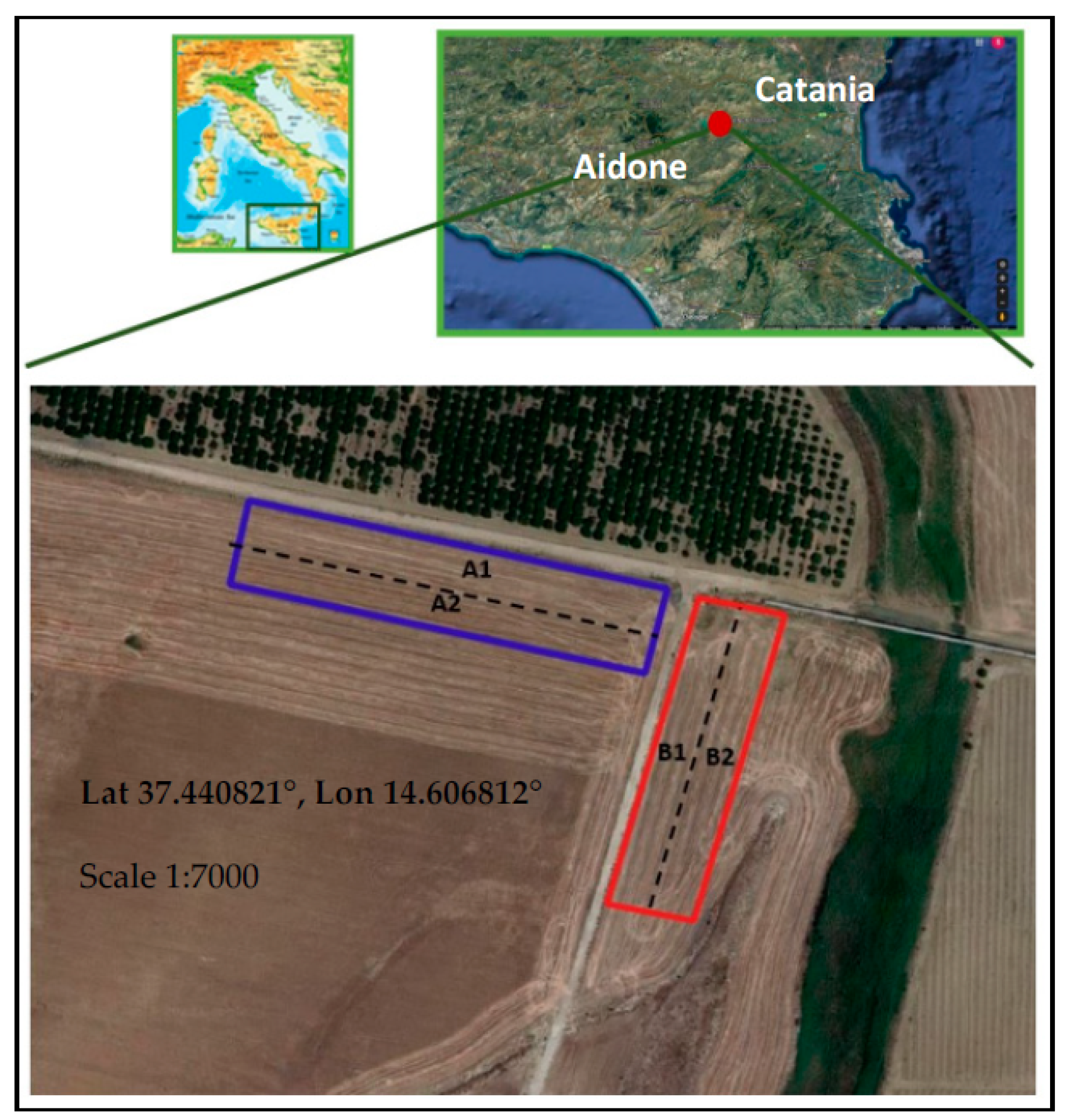
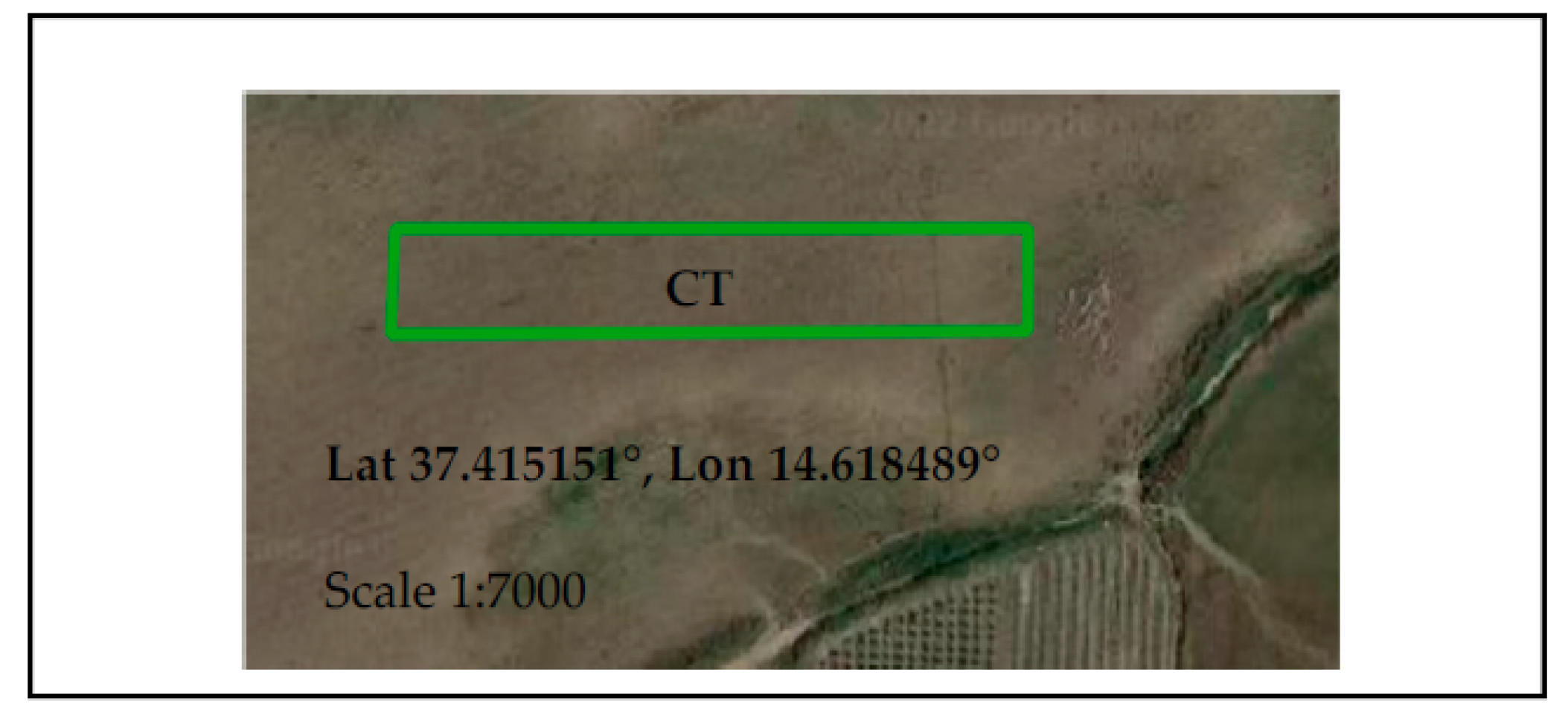
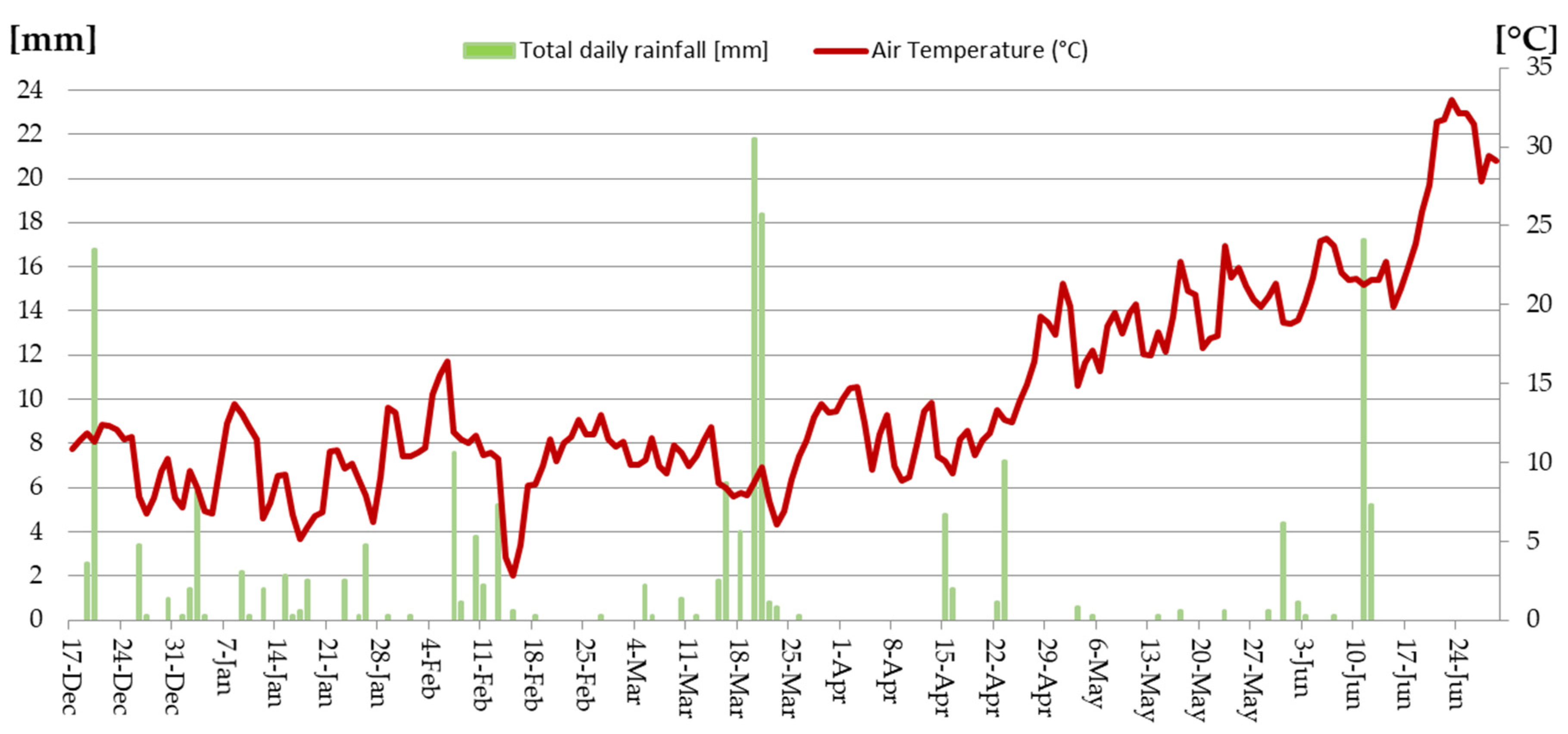
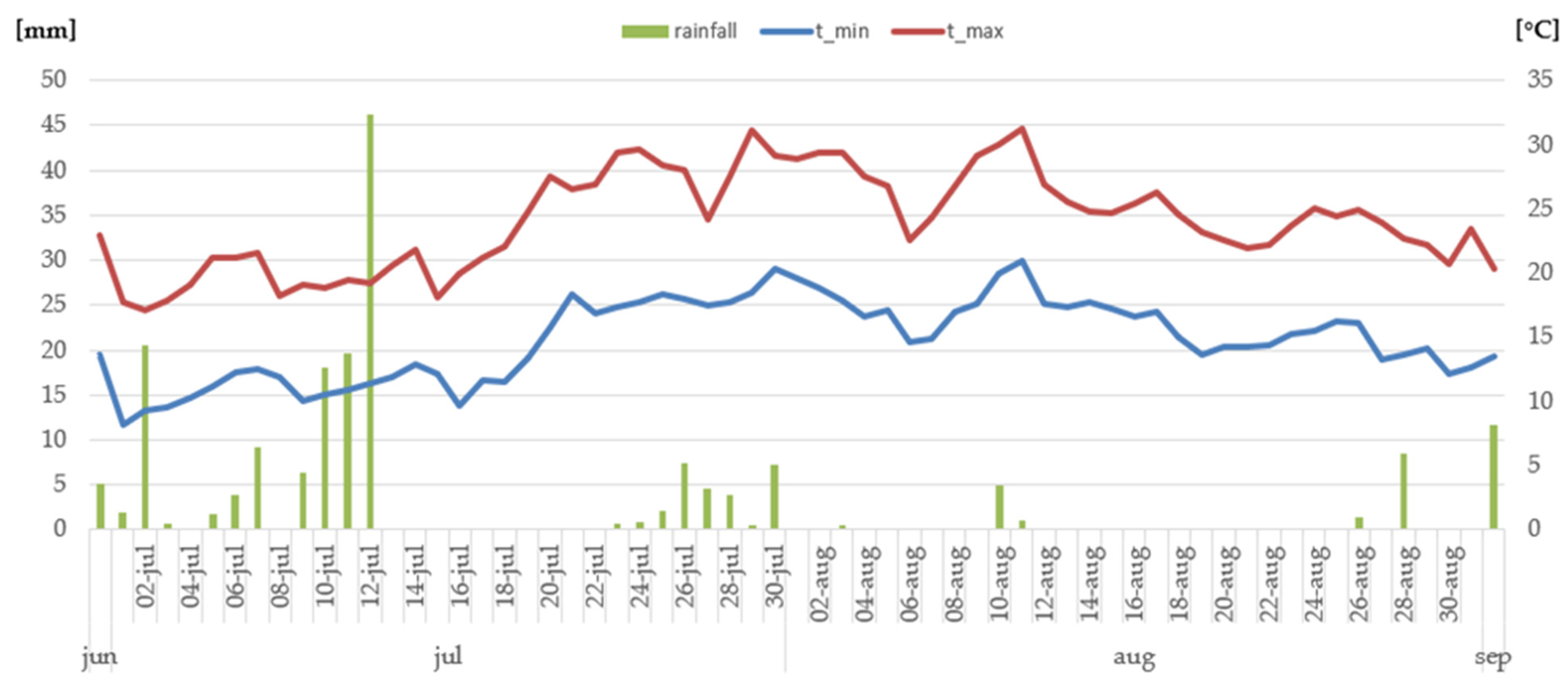

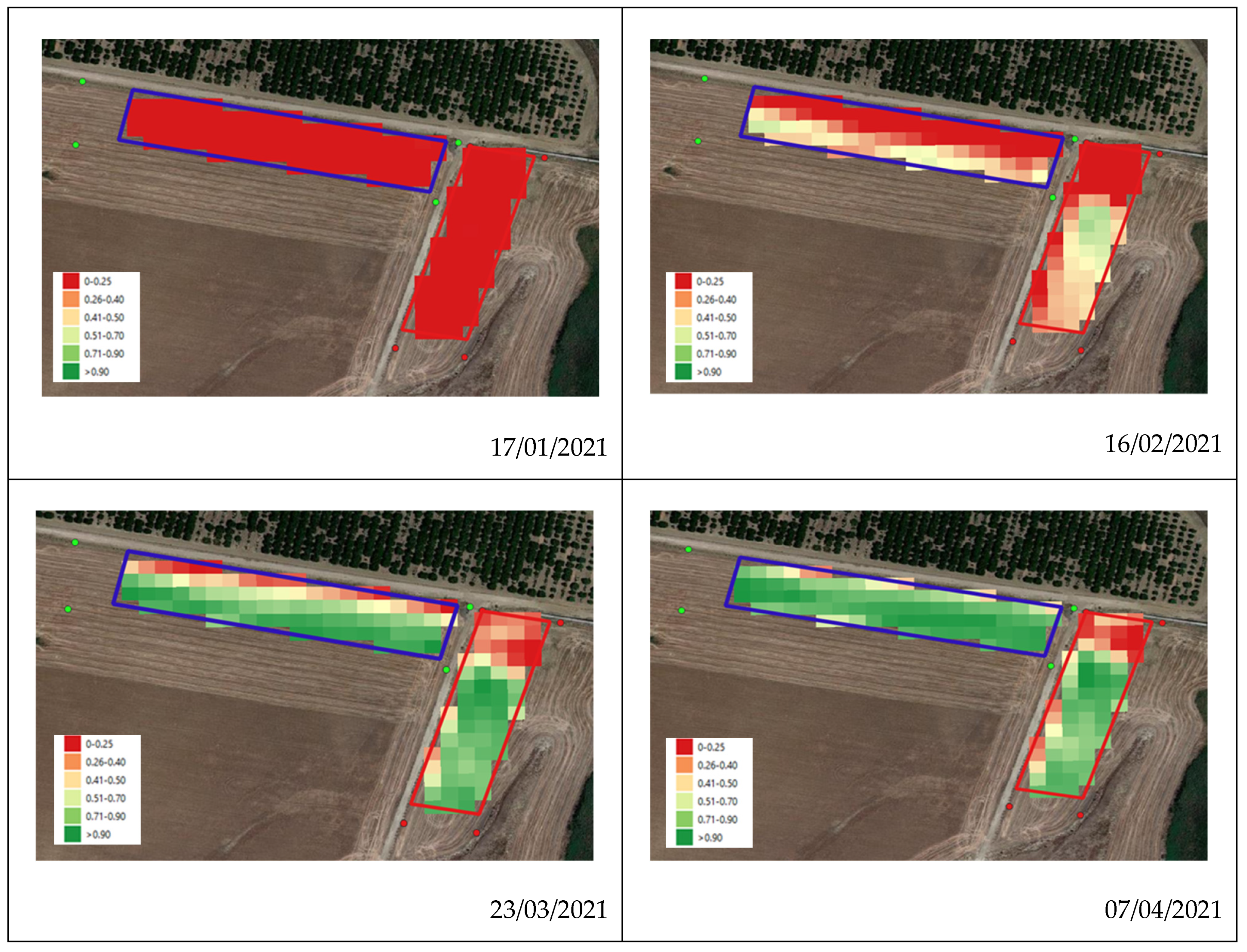
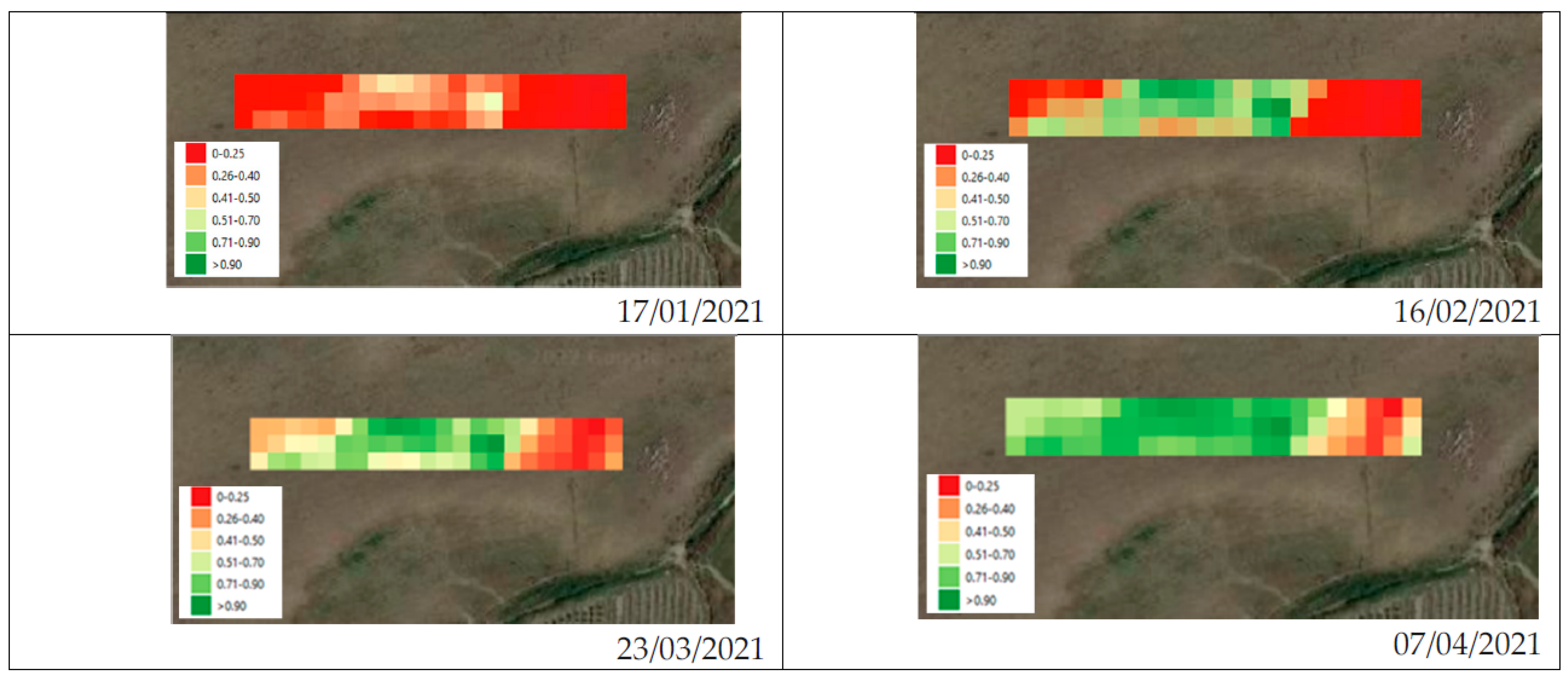



| Plot | ||||
|---|---|---|---|---|
| Properties | Unit | (A1–A2) | (B1–B2) | (CT) |
| Sand | % | 48.32 | 56.58 | 49.85 |
| Silt | % | 26.27 | 22.42 | 42.30 |
| Clay | % | 25.42 | 21.00 | 7.85 |
| Total Lime | % CaCO3 | 16.33 | 16.00 | 9.00 |
| Active Lime | % CaCO3 | 7.00 | 5.67 | 7.00 |
| pH | pH | 8.18 | 8.20 | 8.10 |
| Conductivity | µS cm−1 a 20 °C | 520.33 | 495.00 | 299.00 |
| N | N%° | 1.27 | 1.74 | 1.40 |
| P | P2O5, mg kg−1 | 10.40 | 10.27 | 15.00 |
| K | K2O, mg kg−1 | 677.33 | 560.33 | 830.70 |
| Organic matter | % | 2.17 | 1.91 | 2.01 |
| CEC | meq 100 g−1 | 38.13 | 32.30 | 15.41 |
| Exchangeable K | K, meq 100 g−1 | 1,45 | 1.18 | 1.76 |
| Na | Na, meq 100 g−1 | 7.65 | 8.82 | 1.09 |
| Ca | Ca, meq 100 g−1 | 22.07 | 21.20 | 11.80 |
| Mg | Mg, meq 100 g−1 | 1.42 | 1.09 | 0.79 |
| Fe | Fe, ppm | 9.10 | 52.65 | 8.50 |
| Zn | Zn, ppm | 1.20 | 1.88 | 2.00 |
| Mn | Mn, ppm | 21.00 | 27.10 | 16.80 |
| Practices | Plot Position | Driving Method |
|---|---|---|
| No tillage (NT) | On flat ground (A) | Automatic (A1) |
| Manual (A2) | ||
| On a slope (B) | Automatic (B1) | |
| Manual (B2) | ||
| Control test (CT) | On flat ground (CT) | Automatic |
| Practices | Plot Position | Driving Method | Grain Yield (Mg ha−1) |
|---|---|---|---|
| No tillage (NT) | On flat ground (A) | Automatic (A1) | 4.5 |
| Manual (A2) | 2.5 | ||
| mean | 3.5 | ||
| On a slope (B) | Automatic (B1) | 2.9 | |
| Manual (B2) | 2.6 | ||
| mean | 2.7 | ||
| Control test (CT) | On flat ground (CT) | Automatic | 3.0 |
| Driving Method | NDVI (January–June) | NDVI (March–April) | |
|---|---|---|---|
| Mean value | Manual | 0.48 a | 0.787 a |
| Automatic | 0.41 b | 0.683 b | |
| Minimum value | Manual | 0.02 | 0.237 |
| Automatic | 0.12 | 0.346 | |
| Maximum value | Manual | 0.99 | 0.997 |
| Automatic | 0.93 | 0.935 |
| TEST | NMDI (July–August) | NDWI (July–August) | NDWI (January–June) | NDVI (January–June) | NDVI (March–April) | |
|---|---|---|---|---|---|---|
| Mean | A | 0.37 a | 0.09 a | 0.11 b | 0.46 a | 0.77 a |
| B | 0.36 a | 0.08 a | 0.09 b | 0.44 b | 0.70 b | |
| CT | 0.39 b | 0.03 b | 0.19 a | 0.46 a | 0.79 a | |
| Minimum | A | 0.31 | −0.02 | −0.27 | 0.14 | 0.36 |
| B | 0.31 | −0.02 | −0.27 | 0.13 | 0.24 | |
| CT | 0.32 | −0.06 | −0.26 | 0.03 | 0.46 | |
| Maximum | A | 0.40 | 0.19 | 0.52 | 0.93 | 0.93 |
| B | 0.40 | 0.21 | 0.52 | 0.93 | 0.93 | |
| CT | 0.52 | 0.16 | 0.59 | 0.91 | 0.99 |
| YIELD | NMDI | NDWI | NDWI_JUL_AUG | NDVI | NDVI_MAR_APR | |
|---|---|---|---|---|---|---|
| YIELD | -- | |||||
| NMDI | −0.397 | -- | ||||
| NDWI | −0.480 | 0.993 *** | -- | |||
| NDWI_(JUL_AUG) | −0.341 | −0.304 | −0.310 | -- | ||
| NDVI | −0.634 | 0.403 | 0.412 | 0.698 | -- | |
| NDVI_(MAR_APR) | −0.540 | 0.775 | 0.756 | 0.357 | 0.864 | -- |
Publisher’s Note: MDPI stays neutral with regard to jurisdictional claims in published maps and institutional affiliations. |
© 2022 by the authors. Licensee MDPI, Basel, Switzerland. This article is an open access article distributed under the terms and conditions of the Creative Commons Attribution (CC BY) license (https://creativecommons.org/licenses/by/4.0/).
Share and Cite
Calcagno, F.; Romano, E.; Furnitto, N.; Jamali, A.; Failla, S. Remote Sensing Monitoring of Durum Wheat under No Tillage Practices by Means of Spectral Indices Interpretation: A Preliminary Study. Sustainability 2022, 14, 15012. https://doi.org/10.3390/su142215012
Calcagno F, Romano E, Furnitto N, Jamali A, Failla S. Remote Sensing Monitoring of Durum Wheat under No Tillage Practices by Means of Spectral Indices Interpretation: A Preliminary Study. Sustainability. 2022; 14(22):15012. https://doi.org/10.3390/su142215012
Chicago/Turabian StyleCalcagno, Federico, Elio Romano, Nicola Furnitto, Arman Jamali, and Sabina Failla. 2022. "Remote Sensing Monitoring of Durum Wheat under No Tillage Practices by Means of Spectral Indices Interpretation: A Preliminary Study" Sustainability 14, no. 22: 15012. https://doi.org/10.3390/su142215012
APA StyleCalcagno, F., Romano, E., Furnitto, N., Jamali, A., & Failla, S. (2022). Remote Sensing Monitoring of Durum Wheat under No Tillage Practices by Means of Spectral Indices Interpretation: A Preliminary Study. Sustainability, 14(22), 15012. https://doi.org/10.3390/su142215012










